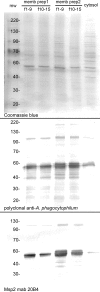Mitogenic component in polar lipid-enriched Anaplasma phagocytophilum membranes
- PMID: 17687112
- PMCID: PMC2168108
- DOI: 10.1128/CVI.00204-07
Mitogenic component in polar lipid-enriched Anaplasma phagocytophilum membranes
Abstract
Human granulocytic anaplasmosis is an emerging tick-borne disease caused by Anaplasma phagocytophilum. A. phagocytophilum cells activate Toll-like receptor 2 signaling and possess mitogenic activity, and A. phagocytophilum infection in vivo activates NKT cells unrelated to major surface protein 2 (Msp2) hypervariable region expression. Thus, we hypothesized that lipoprotein or glycolipid components of A. phagocytophilum membranes could be important triggers of the innate immune response and immunopathology. A. phagocytophilum membranes depleted of Msp2 and protein antigens enhanced the proliferation of naïve mouse splenocytes beyond that of untreated membranes. Protein-depleted and polar lipid-enriched membranes from low-passage A. phagocytophilum cultures enhanced naïve splenocyte lymphoproliferation to a much greater degree than did these fractions from high-passage cultures of bacterial membranes (1.8- to 3.7-fold for protein-depleted fractions and 4.8- to > or =17.7-fold for polar lipid-enriched fractions). These results support the hypothesis that components that are enriched among polar lipids in the A. phagocytophilum membrane stimulate innate immune cell proliferation, possibly activating NKT cells that link innate and adaptive immunity, and immunopathology.
Figures




References
-
- Browning, M. D., J. W. Garyu, J. S. Dumler, and D. G. Scorpio. 2006. Role of reactive nitrogen species in development of hepatic injury in a C57bl/6 mouse model of human granulocytic anaplasmosis. Comp. Med. 56:55-62. - PubMed
-
- Bunnell, J. E., E. R. Trigiani, S. R. Srinivas, and J. S. Dumler. 1999. Development and distribution of pathologic lesions are related to immune status and tissue deposition of human granulocytic ehrlichiosis agent-infected cells in a murine model system. J. Infect. Dis. 180:546-550. - PubMed
Publication types
MeSH terms
Substances
Grants and funding
LinkOut - more resources
Full Text Sources

